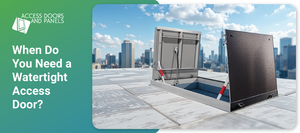When Do You Need a Watertight Access Door?
Posted by Access Doors and Panels on 14th Nov 2024
Watertight access doors are essential components in commercial construction. They provide critical protection against water damage, ensure safety, and maintain building integrity. But when is it necessary to install one? This guide will help you determine when a watertight access door is essential for your project.
What Is a Watertight Access Door?
Before discussing when you need one, let us clarify what a watertight access door is. It helps prevent water from entering a building or specific area. It is constructed with robust materials and features advanced sealing mechanisms to withstand water pressure and infiltration.
Unlike standard general-purpose access doors, watertight access doors are designed to prevent water ingress.
When Is It Necessary to Use a Watertight Access Door?
Several factors, including the building's location, purpose, and specific areas, determine the need to install a watertight access door. Here are some common scenarios in which a watertight access door is crucial:
Commercial Buildings
- Basements and Sub-Basements: Hydrostatic pressure renders these areas particularly vulnerable to flooding. Watertight access doors that withstand high pressure are essential to address this challenge. These doors feature heavy-duty construction materials like steel or reinforced plastic and watertight seals that prevent leaks.
- Plumbing and Mechanical Rooms: Moisture exposure from pipes, leaks, and condensation is a constant threat in these rooms. Stainless or galvanized steel access doors offer superior moisture protection due to their corrosion resistance. Additionally, proper ventilation is crucial to controlling humidity levels and preventing mold growth.
- Roof Access Hatches: Flat roofs are susceptible to rainwater pooling around the access hatch, leading to leaks if not addressed. Watertight roof hatches equipped with proper drainage mechanisms help direct water away from the hatch and prevent infiltration into the building.
- Exterior Wall Panels: Weather exposure can damage traditional access panels. Watertight access doors should be installed within exterior wall panels and be made of durable, corrosion-resistant galvanized steel or aluminum.
- Pool and Spa Areas: High humidity and chlorinated water exposure can cause access panels to corrode and lead to mold growth in pool and spa areas. Watertight access doors constructed with non-corrosive materials like stainless steel or fiberglass can resist damage.
Industrial Facilities
- Wastewater Treatment Plants: These facilities endure harsh chemicals and corrosive elements. Corrosion-resistant watertight doors are essential for safeguarding equipment and maintaining a secure work environment.
- Chemical Processing Plants: Handling hazardous chemicals requires access points that can withstand spills, leaks, and corrosive fumes. Watertight doors with specialized coatings and seals are crucial for safety and prevent contamination.
- Food Processing Facilities: These environments need strict hygiene standards, and watertight access doors made from easy-to-clean materials like stainless steel are crucial for avoiding contamination and adhering to food safety regulations.
- Marine and Offshore Structures: Access doors for marine and offshore structures must be durable and resistant to saltwater corrosion, harsh weather conditions, and heavy loads. Thanks to advanced sealing technology, marine-grade aluminum or stainless-steel doors with reinforced frames and watertight seals can withstand these environments.
Benefits of Watertight Access Doors
Watertight access doors offer many advantages that contribute to the functionality and longevity of a building.
- Protection against water damage: They create a robust barrier against water infiltration, safeguarding your building from costly water damage and preventing structural deterioration and equipment failures.
- Improved indoor air quality: Indoor air quality issues can lead to various health problems. These doors enhance indoor air quality by preventing moisture buildup and mold growth.
- Energy efficiency: Watertight access doors improve energy efficiency by preventing heat transfer and air infiltration, reducing energy consumption and lowering utility bills.
- Enhanced safety: These doors help meet OSHA regulations for workplace safety, enhancing building safety through secure access points.
- Compliance: Watertight access doors adhere to building codes and industry standards, ensuring your building meets regulatory requirements and enhances its value.
Choosing the Right Watertight Access Door
When selecting the appropriate watertight access door, consider size, material, load capacity, insulation requirements, and installation specifics. For instance, the BA-WTFD watertight floor door is an excellent choice for areas requiring high load capacity and watertight seals.
You make an informed decision with the help of a professional. Carefully selecting watertight access doors will protect your investment and ensure long-term building performance.
Conclusion
Watertight access doors are crucial for a building's safety, function, and integrity. From basements to factories, these doors shield against water damage. Contractors can strategically place watertight access doors by assessing location, purpose, and environment. These reliable components are strategic investments safeguarding building value.
Watertight access doors are more than just entry points. They are essential safeguards that protect buildings from water damage and optimize interior environments.
Do not let water damage compromise your building's integrity. Invest in reliable watertight access doors from Access Doors and Panels. Our team is ready to assist you. Call (800) 609-2917 or request a quote online today.

